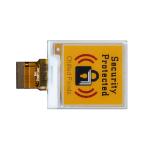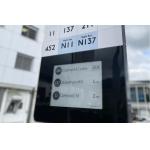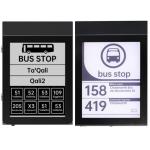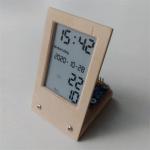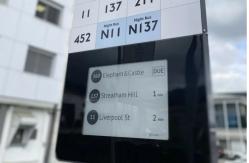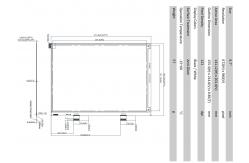9.7'' e-paper display module with touch wide temperature custom
optional
well-equipped bus stop signage system
E-paper display bus stop signs are a modern and innovative way to
provide real-time transit information to commuters using e-paper
(electronic paper) technology. E-paper is a display technology that
mimics the appearance of ink on paper, offering benefits like high
visibility, low power consumption, and the ability to be easily
readable in direct sunlight, which makes it an ideal choice for
outdoor environments like bus stops. Key Features of E-Paper Bus Stop Signs:Real-Time Information: E-paper bus stop signs can display real-time updates about bus
arrivals, departures, delays, and other critical transit data.
These updates can be pulled from a central server, ensuring that
commuters always have the latest information. Low Power Consumption: One of the major advantages of e-paper technology is its
extremely low power usage. E-paper displays only consume power when
the content is updated, making them ideal for outdoor use where
frequent recharging or wiring for power might be challenging. Excellent Readability in All Lighting Conditions: Unlike traditional digital displays, e-paper displays are highly
visible even in bright sunlight, which is a major advantage for
outdoor applications like bus stop signs. They have a paper-like
quality that ensures legibility no matter the time of day or
lighting conditions. Durability: E-paper displays are often rugged and weather-resistant, making
them well-suited for outdoor environments. They can withstand
varying weather conditions, such as rain, wind, and extreme
temperatures, ensuring long-term use with minimal maintenance. Eco-Friendly: Since e-paper displays use less power and are often made from
recyclable materials, they contribute to sustainability goals,
which is important for modern transit systems looking to reduce
their environmental impact. Dynamic Content: E-paper technology can show dynamic content such as bus
schedules, live updates, and even advertisements. This flexibility
allows transit authorities to update bus stop signs remotely
without requiring physical maintenance or manual updates.
Advantages:- Energy Efficiency: Due to its low power needs, e-paper bus stop signs can run on
solar power or be connected to low-power networks, reducing
infrastructure costs.
- Maintenance: E-paper signs have fewer moving parts compared to traditional
digital displays, leading to lower maintenance costs over time.
- Cost-Effective: Although the initial setup cost might be higher than traditional
signage, the long-term savings on power and maintenance can make
e-paper a cost-effective solution.
| Item | STANDARD Value | | LCD size | 9.7 inch | | LCD Display Type | E-ink | | LCD Display Mode | monochrome, black and white | | Recommended Viewing Direction | free view | | Display colors | 16.7 M | | Resolution | 672*960 | | Operating temp | -15 to +65 degree C |
Applications
Use Cases:- Urban Transit Systems: E-paper bus stop signs are increasingly being deployed in urban
settings to give passengers up-to-date information about bus
schedules, expected arrival times, and service disruptions.
- Sustainable Solutions: In cities and towns with a focus on sustainability, e-paper bus
stop signs offer an energy-efficient alternative to traditional
electronic signs, which often consume much more power.
Update rates
The update rate for e-paper bus stop signs typically ranges from once every few seconds to once every minute, depending on the requirements of the specific system and the
information being displayed.
Here's a breakdown of the typical update rates: 1. Real-Time Updates (Every Few Seconds):- Use Case: When displaying live data such as bus arrival times, delays, or
traffic conditions, updates might occur as frequently as every 10 to 30 seconds.
- Reasoning: This allows commuters to see up-to-the-minute changes in the bus
schedule, especially in cases where there are significant delays or
last-minute changes.
2. Scheduled Updates (Every Minute):- Use Case: For less dynamic information, such as standard bus schedules or
route information, the update rate might be set to 1 minute or longer.
- Reasoning: Bus schedules generally don't change frequently within a short
time frame, so updating once a minute is sufficient for most needs.
3. Static or Low-Frequency Updates:- Use Case: If the sign is displaying static content like advertising or
general route information that doesn't change often, updates might
occur every several minutes or even hours.
- Reasoning: Content like routes or general messaging only needs to be updated
on a less frequent basis, which reduces power consumption and wear
on the system.
Factors Influencing Update Rates:Power Consumption: E-paper displays are designed to consume minimal power, but
frequent updates can increase energy consumption. The display only
uses power during updates, so a balance must be struck between
providing real-time updates and maintaining energy efficiency. System Requirements: The specific transit system's needs will determine the update
rate. Systems with higher volumes of commuters or more dynamic
routes (e.g., frequent delays or route changes) may require faster
update rates, while quieter systems may work with slower update
cycles.
In Practice:- Typical Update Rates: In most cases, update rates for e-paper bus stop signs range from
10 to 60 seconds, depending on the importance of the information being displayed.
This ensures commuters receive timely updates without unnecessarily
draining power or requiring constant data transmission.
Packaging & Shipping
Packaging : All the products are packed in right way to keep it safe. For
small sizes of products we often use tray + carton, and for bigger
sizes we use foam slot + carton. Also we can design packages to
meet customers' requirements. Shipping : For small quantity orders: We often ship by UPS Air-Express, or
DHL/FEDEX/TNT/ EMS Express service. And For large quantity orders: we ship by buyer's cargo agent in China.
Also, we can ship by air or sea transportation by our cargo agent. Delivery Time:
Ready-made Sample: within 1 week Custom Sample: 1~2 weeks Mass production: 3-4 weeks
FAQ
1. Do you offer customized service?
-Yes, we offer OEM&ODM service and send us your requirements.
2. What payment methods do you accept?
-We accept via TT/West Union/Paypal.
3.Do you provide samples?
-Yes, we offer sample but you need to pay sample fee and delivery
fee.
4. How long does it take to produce the product?
-It depends on the product you need. Different needs determine the
production time
5. What's the process for placing an order?
-PO is placed by clients → PI is issued by Royal Display → Payment
by clients → Lead time is confirmed by Royal Display → Shipping
instrction by Clients → Delivery → Cargo tracking → Receipt of
cargo
|
